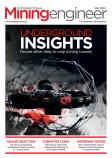The world we live in evolves, improves and innovates on a daily and sometime hourly basis. All industries and industry sectors share in these advancements and are primarily responsible for the progress of the human race. The mining industry is not excluded from this phenomenon, but some areas of mining are. Looking at wear protection as an example, the same materials, ideas and philosophies have been followed for years without innovation. Haul truck tray liners are a good example. The same materials that were used years ago are still in use today and the only innovation is to install thicker, heavier liners when wear life has to be increased.
Liner installation
A chain is as strong as its weakest link. Even with the most advanced materials and products available, installation plays a vital role. When the installation technology fails, the solution fails. With wear protection, a failed liner results in aggravated wear of the sub-structure, causing direct equipment damage, unplanned maintenance and increased operating costs.
The general practice for installing haul truck liner systems is to weld them in place. In essence, this is good practice, but due to structural deformations, flatness of the tray structure is compromised and when installing a flat liner on top of a warped structure, cavities exist between the liner and the structure. These cavities result in a loss of much needed structural support the tray body provided to the liner system leaving the liners free to move and deform as the tray is being loaded and unloaded. This movement causes stress in both the liners and the welded joints causing premature liner and joint failures.
Old versus new
Quenched and tempered (Q&T) hardwearing materials have been around for decades. Their limitations are however situated in their properties and manufacturing processes. These are in essence low-alloy steels that have been heat treated to high hardness. With hardness not being a direct measure of wear resistance, they fall short when compared to hardfaced plate, which has also been around for some time, but exhibit a complete different structure where ultra-hard carbides are embedded in a softer, more ductile matrix. These materials can be compared to the structure of a tar road, where the much harder crushed rock particles provide the bulk of the road’s properties. Without these rock particles, the road will not last nearly as long.
Due to their metallurgical structure, WA Hardplate liners have a wear life of up to 10 times that of Q&T material and can very often be much thinner then their Q&T counterparts, resulting in a substantial weight advantage.
Innovative approach
The Welding Alloys Group (WAG) prides itself on being a leader in the field of wear protection materials and solutions. Makuri IMD is an innovative solution, aimed at wear protection in large-dig load and haul equipment for the mining and earthmoving industries. Instead of a product, Makuri IMD focuses on the three main aspects of successful wear protection, these being installation (I), materials (M) and design (D).
A longer lasting liner system ensures a lower operating cost. In a perfect world, the optimum wear life of Hardplate overlay materials is measured from date of installation until the entire Hardplate overlay has been worn away. The perfect world does not exist, but striving towards it does. Through innovative designs, advanced materials and optimised installation, liner systems can now stay in place for longer by filling the cavities between the flat liners and warped or damaged equipment structure with a backing compound or grout. Deformation of liners, increased stresses in welded joints and localised or preferential wear are greatly reduced. Dangers of misplaced liners due to weld failure are that they typically end up inside crushers, damaging or clogging downstream equipment or cutting through conveyor belting.
As the famous saying goes, “insanity is doing the same thing over and over again and expecting different results.” Through innovation, advanced wear-resistant materials, equipment-specific designs and optimised installation techniques, the Makuri IMD liner system provides what its inventors believe to be the lowest operating cost per ton of any liner system available, adding value through cost of ownership to large-dig load and haul equipment.
André Bouwer is with Welding Alloys South Africa & Pieter du Plessis is with Integra (Welding Alloys Group).
www.welding-alloys.com





















